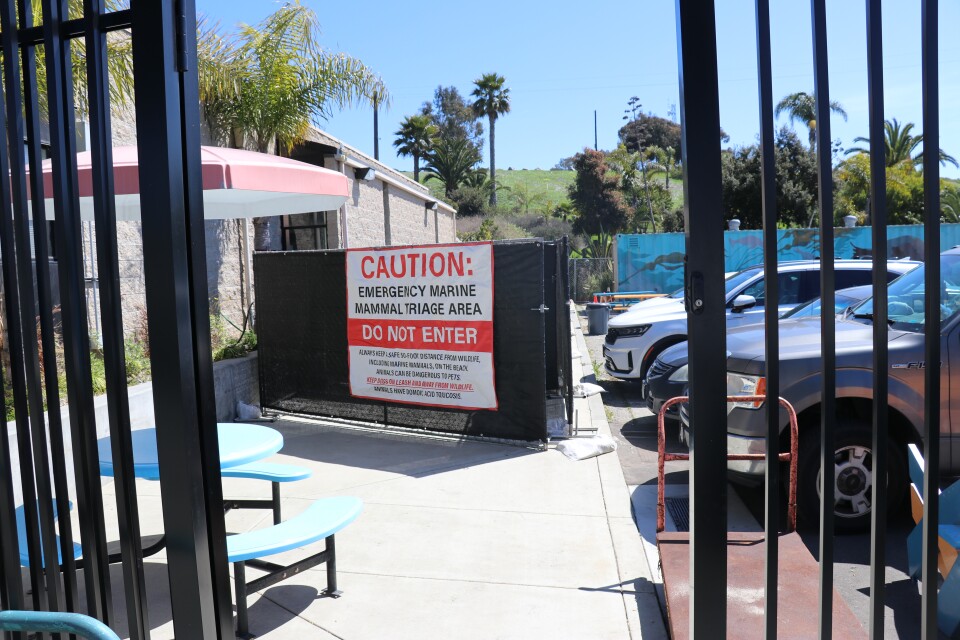Truth matters. Community matters. Your support makes both possible. LAist is one of the few places where news remains independent and free from political and corporate influence. Stand up for truth and for LAist. Make your year-end tax-deductible gift now.
SoCal’s sick sea lion problem is getting much worse: ‘We just can’t rescue them all’
A toxic algae bloom that’s harming marine life in Southern California is escalating.
The bloom, which in February was initially focused on the Malibu coast, has spread across Southern California. Facilities are struggling to deal with an influx of sick animals with domoic acid toxicosis — that’s when an algal bloom puts out a harmful neurotoxin affecting animals' brains and hearts.
The situation now
Dave Bader, a marine biologist with the Marine Mammal Care Center in San Pedro, said the center has more than 70 animals in its care, most of which have domoic acid poisoning. The facility responds to stranding events on the L.A. County coastline — stranding means an animal was found on the beach and is unable to return to water.
The center has incurred almost $200,000 in costs that it's trying to recoup through fundraising.
“We are near capacity, and it’s forcing us to make some tough decisions,” he said.
“ Unfortunately, some animals are on the beach for longer than we would like them. We just can’t rescue them all.”
Bader said most of the animals stranding are pregnant sea lions, who tend to give birth to stillborn pups. But the center is also seeing male sea lions, seabirds and more than 50 dolphins get infected. They’ve added a triage space in their parking lot to keep up. The demand has led to many bad days for the center’s staff.

“ To see animals suffering like this, it takes an incredible emotional toll,” Bader said.
The amount of dolphins stranding is notable, as these mammals only come ashore when they’re very, very sick.
“ To be washed ashore means that you’re either no longer living or very close to passing on,” he said.
This toxic algal bloom is happening sooner than usual, according to Bader, in part because of human-caused climate change — oceans are becoming more acidic with excess nutrients, creating ideal settings for blooms. (As we reported in February, the wildfires didn’t cause the bloom but debris runoff may have contributed to it.)
“ Everything is a little bit messed up right now,” Bader said. “ We could be fairly confident and say, hundreds to potentially even thousands of animals [are] being impacted.”
Bader said they have about a 60% survival rate, but it’s the scale that’s causing concern. “ This seems worse.”
The bloom appears stronger than in previous years
Many factors can contribute to a bloom’s intensity.
What’s mostly driving this event is Pseudo-nitzschia, a type of plankton that produces domoic acid. More than a million cells per liter have been found off the Southern California coast, much higher than the 10,000 per liter and above that’s considered a concern. According to the Southern California Coastal Ocean Observing System, it’s the highest concentration ever recorded.

The organization said this is also an “unprecedented multiple-toxin event” because there’s another neurotoxin circulating in addition to domoic acid.
According to the Scripps Institution of Oceanography, unsafe levels of saxitoxin have now been found in Santa Barbara, which causes paralytic shellfish poisoning.
It may be a while before this harmful algal bloom is over — they can last weeks or even months.
California’s largest harmful algal bloom on record happened from May to August 2023, resulting in more than 1,000 sea lion deaths. This year's event started Feb. 21 with more than 330 animals reported so far, according to the Coastal Ocean Observing System. This is the region’s fourth year in a row dealing with it.
Domoic acid events usually harm mostly marine life, but humans can get sick if they come into contact with infected animals or ingest contaminated foods. The California Department of Public Health has issued a warning to the public to not eat sport-harvested bivalve shellfish in L.A. and Santa Barbara counties.
What can you do?
Experts warn that sick animals can be unpredictable. Sea lions may move their head around in a motion known as “stargazing,” be aggressive to people, or appear lethargic or comatose. A sick sea lion has already charged and bitten a surfer near Oxnard.
If you see any animals stranded on the beach, you should stay at least 50 feet away. Bader said when people try to help dolphins by pushing them back out to sea, it can actually stress the animal more during what may be its last moments.
And while non-service animals aren’t allowed at most L.A. County beaches, make sure pets stay on a leash if you do decide to shirk the rules.
To report sightings, call the Marine Mammal Care Center at (800) 39-WHALE. You can also contact the California Wildlife Center, which serves the Malibu area, through its marine mammal rescue hotline at (310) 924-7256.











